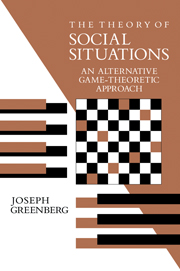Book contents
- Frontmatter
- Contents
- Preface
- 1 Overview
- 2 The theory of social situations
- 3 Examples
- 4 Abstract stable sets
- 5 Existence and uniqueness of OSSB and CSSB
- 6 Characteristic function form games
- 7 Normal form games
- 8 Extensive form games with perfect information
- 9 Infinitely repeated games
- 10 Implementation by means of situations
- 11 Closing remarks
- References
- Index
2 - The theory of social situations
Published online by Cambridge University Press: 05 June 2012
- Frontmatter
- Contents
- Preface
- 1 Overview
- 2 The theory of social situations
- 3 Examples
- 4 Abstract stable sets
- 5 Existence and uniqueness of OSSB and CSSB
- 6 Characteristic function form games
- 7 Normal form games
- 8 Extensive form games with perfect information
- 9 Infinitely repeated games
- 10 Implementation by means of situations
- 11 Closing remarks
- References
- Index
Summary
The theory of social situations has two main ingredients. First, it offers a unified way to represent social environments, namely, by means of “situations.” Second, it offers a unified criterion for the recommendations, namely, that the “standard of behavior” (for the given situation) be “stable.”
Situations
The notion of a “situation” defined below provides a complete description of the social environment. It specifies in an explicit and detailed manner the opportunities that are available to the agents.
To motivate and facilitate the definition of a situation, consider the game of chess. The set of players consists of two individuals: Black and White. There is a collection, say, C, of “admissible” configurations of the pieces on the board. For example, every configuration in C must be such that both kings are present on the board and occupy nonadjacent squares. For each pair (c,i), where c is a particular configuration in C and i is one of the two players, there is a set of configurations in C that player i can “induce” from c, if it is i's turn to make a move once c was reached. When this set is empty player i is checkmated. Clearly, all induced configurations must themselves be admissible, that is, belong to C, since the rules of the game apply to such and only such configurations.
- Type
- Chapter
- Information
- The Theory of Social SituationsAn Alternative Game-Theoretic Approach, pp. 9 - 26Publisher: Cambridge University PressPrint publication year: 1990



